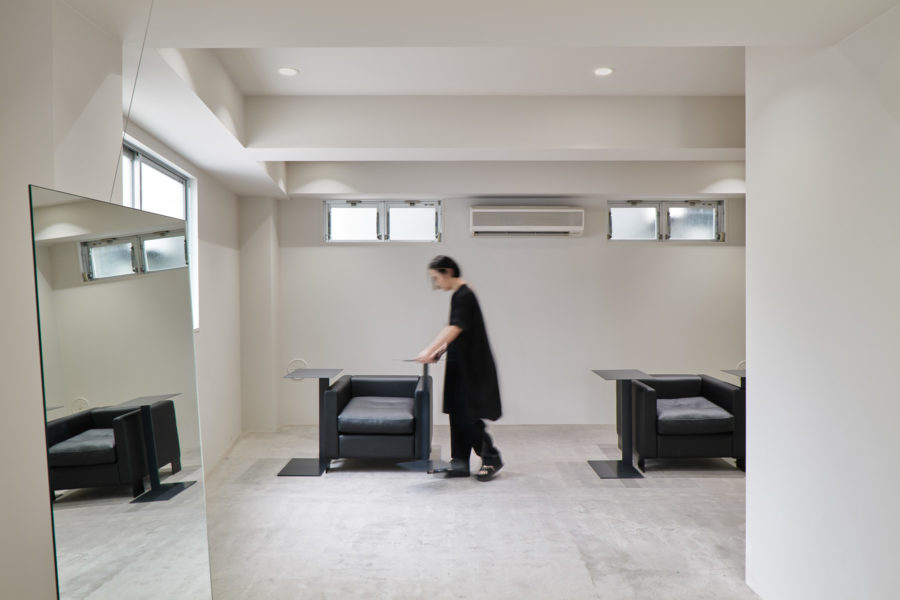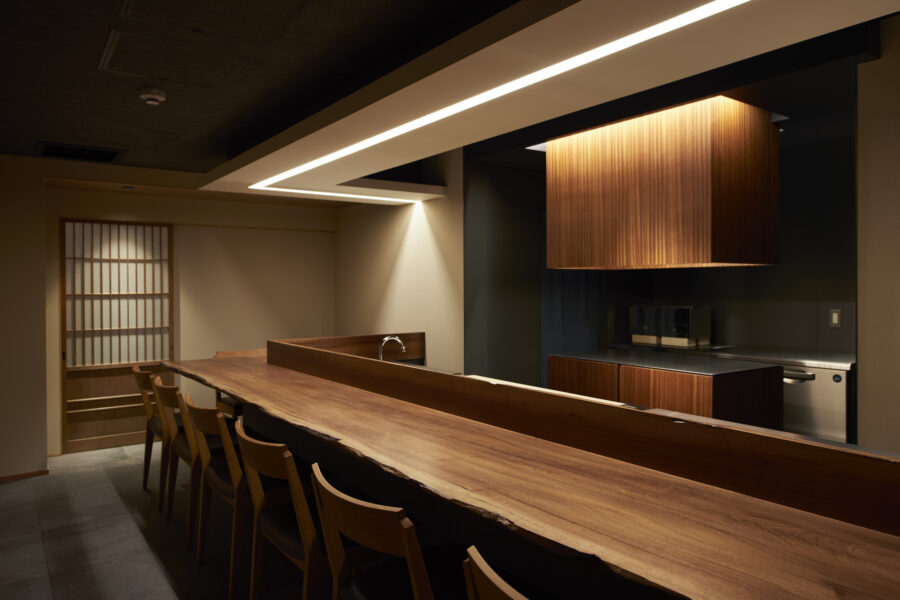海水浴場すぐそばの土地に建つ木造住宅を改修し、設計者の自邸と仕事場、そして知人が営むカレー屋とした。その古い木造住宅の2階には、空と海だけをぽっかりと切り取る小さな窓があった。
海水浴場へと続く人通りの多い道路に対しては緩衝帯として庭を設け、その奥に、カレー屋、設計事務所、住宅、と段階的に街と繋がるようにした。73m²と決して広くない建物に3つの用途を同居させているので、それぞれの用途は、専用のエリアをもちつつも部分的に兼用し、じんわりと溢れ出しながら緩やかに繋がっている。2階は既存の壁を取り払い1つのワンルームとし、海と繋がる北西角部に全開口できる木製建具を設けた。窓台の高さを630mmと低めに抑えていることもあり、開け放つと室内と海は渾然一体となる。海からの強烈な潮風に対しては建具の見込みを54mmと厚くすると共に、外部側からも締めることができる鍵を設置した。
この家を設計しながら意識したのは「混在」についてだった。用途、文化や国籍、時間や空間、街と家、仕事と生活、この家を取り巻くさまざまな混在の在り方に注意を払いながら設計を進めていった。
自由に海外旅行ができ、インターネットで瞬時に世界と繋がることができる現代。街中には世界各国の専門料理店があり、普段気が付かないような生活の細部にまでさまざまな国の文化が入り混じっている。住宅も同様に、建材や意匠、すべてにおいて意識されることなくさまざまな国の文化や性質が混在している。意識して純粋な和風住宅をつくろうとでもしない限り、異国の文化は自然と入り込む。日本のスタンダードとなった「多国籍な住宅」は、もはや文化という文脈から離れ、無秩序に拡大している。
設計にあたって、今一度自身のルーツや文化的背景を理解した上で、この地に古くからある材料や技法を用いながら、異国のエッセンスを混在させることで「多国籍な住宅」を更新することができないかと考えた。また、それは日本の住宅文化を再評価するきっかけにならないかと考えた。
例えば、土間の敷瓦は、この地域がかつて瓦の一大産地だったことに由来し、テクスチャやエッジの形状に中南米の街で見た溶岩の石畳のイメージを重ねたものを、淡路の瓦職人に1つひとつ手仕事で製作してもらった。障子には蚊帳のようにも見えるネットや簾を張り、熱帯とノスタルジアに思いを馳せた。障子や襖など不完全な仕切りで空間を透かしながら繋がってゆく奥ゆかしい平面空間は日本古来の建築の姿だが、この家では断面方向にも空間は繋がり、南国原産の下垂する植物が適度に空間を隔てる。大工の手仕事が活きる細やかなディテールには、樹種や調色を吟味することで異国の空気を宿した。2階の海と対峙する壁は、弁柄を混ぜた掻き落とし壁とし、淡路の左官職人に仕上げてもらった。これは各国にある色鮮やかな壁を建築に取り入れる手法を、日本的な文脈の中で試みたものだ。
時間の混在が空間に奥行きを生むと考えた。新旧の対比を際立たせたり、全体を古いものに合わせたりするのではなく、古い素材やデザインをある時間軸をもつ要素の1つとして捉え、新たに追加した部分を含めて全体として長い時間の幅を感じられる空間を目指した。それは古くもあり新しくもある空間。既存の柱梁と新しい柱梁は縦横無尽に入り乱れ、既存の型板ガラスが透けて見えるかたちで新たな建具が重なる。扉には旅先で購入した年代の知れない取手が付き、檜の化粧柱が悠久の時を感じさせる自然石の上にひかりつけられる。さまざまな時間軸をもった素材が混在し、共存する。新たに追加した素材は経年で味わいが増し、時と共に常に美しい姿を感じさせるものを選択している。
簾の隙間から事務所にこぼれるカレーに舌鼓を打つ人々の楽しそうな会話。視線を向けると、客席のさらに向こう、芭蕉(バショウ)や棕櫚竹(シュロチク)の葉叢の間からサーフボードを持った若者たちが楽しそうに海岸へ向かう姿が見える。この家の2階には、空と海だけをぽっかりと切り取る大きな窓がある。窓辺で貪る午後のまどろみに、厨房から立ち上る香辛料の香りが夢の中に異国情緒を添えてくれることもあるだろう。この家では、さまざまなものが、活き活きと混在している。この混在は、あらゆるものを受け入れる海のような大らかさを生み、身を委ねるものの意識を水平線の向こうまで導いている。(一色暁生)
A residential renovation with the essence of exoticism into a Japanese context
A wooden house on a plot of land near a beach was renovated to become the designer’s own residence and workplace, as well as a curry shop run by an acquaintance. On the second floor of the old wooden house, a small window cut out only the sky and the sea.
The garden was placed as a buffer zone against the busy road leading to the beach, and at the back of the garden, the curry shop, the design office, and the house were connected to the town in stages. 73m2 is not a large building, so each use has its own area, but they are partially used together and gradually overflow into each other. On the second floor, the existing walls were removed to create a single room, and wooden fittings were installed at the northwest corner of the room that connects to the sea, which can be opened fully. The height of the window sill is kept low at 630mm so that when the window is open, the room and the sea become one with each other. The fittings are thicker (54mm) to protect against the strong sea breezes, and locks have been installed to lock them from the outside.
While designing this house, I was conscious of “mixing.” We paid attention to the various ways the place is mixed in terms of use, culture and nationality, time and space, town and home, work and life, and so on.
Today, we can freely travel abroad and instantly connect with the world via the Internet. There are restaurants specializing in foods from all over the world in the city, and cultures from various countries are mixed into the details of our daily lives that we do not usually notice. Similarly, in housing, building materials, design, and everything else, the cultures and characteristics of various countries are mixed in without being consciously noticed. Unless one consciously tries to create a purely Japanese-style house, foreign cultures will naturally enter the house. The “multinational house” that has become the standard in Japan is no longer in the context of culture but is expanding uncontrolled.
In designing this project, after once again understanding my roots and cultural background, I wondered if it would be possible to update the “multinational house” by mixing the essence of other countries while using materials and techniques used in this region for a long time. We also wanted to know if this would allow us to re-evaluate Japanese housing culture.
For example, the tiles on the earthen floor were handmade by Awaji tile artisans, whose textures and edges are reminiscent of lava stone pavement seen in Central and South American cities. The shoji screens are covered with nets and bamboo blinds that look like mosquito nets, evoking thoughts of the tropics and nostalgia. The house is also connected in the cross-sectional direction, and the space is moderately separated by drooping plants native to the tropics. The wall facing the sea on the second floor is a scraped-off wall mixed with a petal pattern and finished by a plasterer from Awaji. This is an attempt to incorporate the colorful walls of other countries into the architecture in a Japanese context.
We thought that the mixing of time would create depth in the space. Rather than accentuating the contrast between the old and new or making the entire building fit the old, we considered the old materials. We designed one element with a certain time axis. We aimed to create a space where the whole, including the newly added parts, gives a sense of an extended time range. It is a space that is both old and new. The existing columns and beams and the new columns and beams are intermingled in every direction, and the new fittings are superimposed on the existing mold plate glass. The doors have handles of unknown age purchased on a trip, and decorative cypress pillars are set against natural stone that evokes a sense of time long past. Materials from various periods are mixed and coexist. The newly added materials have been selected for their beauty, which will continue to develop over time.
People enjoy talking over curry, spilling into the office through a gap in the bamboo screen. Looking out, one can see young people with surfboards happily heading to the beach through the foliage of basho (Japanese banana) and palms of bamboo further beyond the seating area. On the house’s second floor, a large window opens onto the sky and the sea. In the afternoon slumber, you devour by the window. The aroma of spices from the kitchen may add an exotic touch to your dreams. In this house, various things are mixed vividly and as they are. This mixture creates an ocean-like openness that accepts all things, guiding the consciousness of those who surrender themselves to it to the horizon beyond. (Akio Isshiki)
【林崎松江海岸の家 / カレーハウスバブルクンド】
所在地:兵庫県明石市
用途:戸建住宅、レストラン
クライアント:個人
竣工:2023年
設計:一色暁生建築設計事務所
担当:一色暁生
造園:abcde studio
施工:笹原建設
撮影:大竹央祐
工事種別:リノベーション
構造:木造
規模:地上2階
敷地面積:98.20m²
建築面積:47.77m²
延床面積:73.31m²
設計期間:2022.03-2022.08
施工期間:2022.09-2023.03
【House in Hayashisaki Matsue Beach / CURRY HOUSE Babbulkund】
Location: Akashi-shi, Hyogo, Japan
Principal use: Residential, Restaurant
Client: Individual
Completion: 2022
Architects: Akio Isshiki Architects
Design team: Akio Isshiki
Landscape: abcde studio
Contractor: Sasahara Construction
Photographs: Yosuke Ohtake
Construction type: Renovation
Main structure: Wood
Building scale: 2 stories
Site area: 98.20m²
Building area: 47.77m²
Total floor area: 73.31m²
Design term: 2022.03-2022.08
Construction term: 2022.09-2023.03








